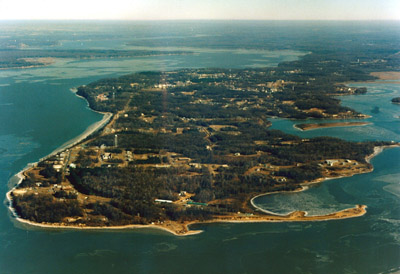
Founded in 1890, the Naval Proving Ground at Indian Head was the Navy’s first established presence in southern Maryland. By 1913, the original mission of Indian Head evolved one step farther. Work gradually moved away from the simple proving of guns and armor to include standardization of shells and powder. In 1915 an ammonium picrate plant was opened to expand the chemical research program, both routine and experimental. When the United States entered World War I in 1917, the Naval Powder Factory was a major producer of smokeless powder for the Navy.
After 1921 Indian Head was no longer designated as the "Naval Proving Ground" but was referred to as the "Naval Powder Factory." The facility had shifted from a naval gun proving ground to a chemical factory, research laboratory and Explosive D factory. The World War II years brought rapid growth to the facility, which was considered one of the leading war-supply stations. Another expansion centered in the area of production. Indian Head put into operation an extrusion plant for pressing ballistite powder into rocket "grains," while continuing to produce smokeless powder and Explosive D.
In 1947, the Bureau of Ordnance agreed to the establishment of a set of pilot plants at Indian Head that would have the capacity to produce experimental new propellants for naval research use: a nitroglycerin pilot plant; a plant to produce varied nitrogen-content nitrocellulose; a plant for mixing and rolling experimental lots of solvent and solventless propellant; and a fourth plant for experimental production of cast propulsion units.
During the 1950s, the Korean conflict provided the impetus for the factory's stepped up explosive and propellant production. Building on work done at the facility's Patterson Pilot Plant during the 1940s, the factory began to produce missile fuel for the long-range Polaris missile and smaller rockets, and later, propellants for emergency ejection mechanisms. Reflecting its new mission and direction, the Naval Powder Factory shed its former name and officially became the Naval Propellant Plant in 1958.
Reflecting the diversification from propellants into related fields of chemistry, engineering and production contract management, the Naval Propellant Plant again changed its name, becoming the Naval Ordnance Station (NOS) in 1966. The mid to late-1960s were characterized by the production of such products as the plastic explosive C-3 in 1965, an updated Zuni rocket in 1966, Polaris casting powder from 1961 through 1967, Poseidon casting powder (C-3) in 1967, and composite propellant and PBX explosive processing.
Recognizing the achievement of the station, Naval Sea Systems Command reconstituted several of the previously acquired agency roles as official "centers of excellence" for the Navy. This meant that the Navy would not duplicate the effort elsewhere and would treat the facility as the primary collection of experts in a particular area. NOS acquired the "center of excellence" designation by mid-1989 for six technologies: guns, rockets and missiles; energetic chemicals; ordnance devices (CAD/PAD); missile weapon simulators; explosive process development engineering; and explosive safety, occupational safety and health, and environmental protection.